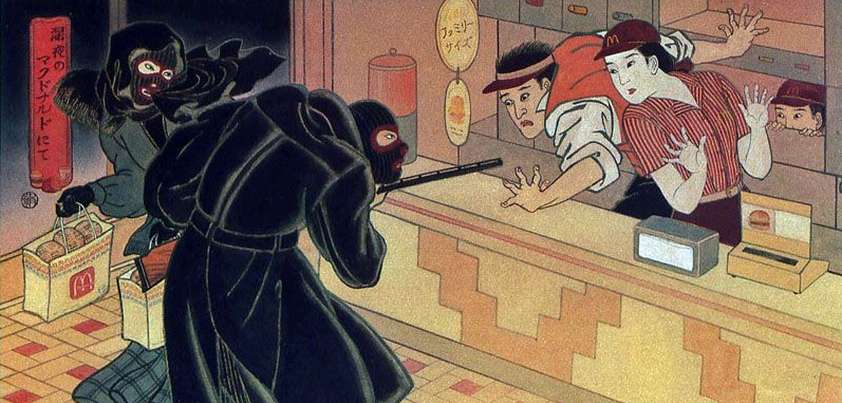 This story by Haruki Murakami describes how a reclusive man made 1971 his “year of Spaghetti”. After buying the necessary equipment and ingredients, he set out to cook spaghetti every day of the year. He cooked spaghetti to live and lived to cook spaghetti, comparing it to an act of revenge against his fears and feelings of meaningless isolation. Although he always eats alone, he often imagines someone standing outside about to visit. When his peace is shattered by a desperate phone call from an ex-friend’s ex-girlfriend, he declines to get involved. Themes include loneliness, self-alienation, obsession, futility. More…
This story by Haruki Murakami describes how a reclusive man made 1971 his “year of Spaghetti”. After buying the necessary equipment and ingredients, he set out to cook spaghetti every day of the year. He cooked spaghetti to live and lived to cook spaghetti, comparing it to an act of revenge against his fears and feelings of meaningless isolation. Although he always eats alone, he often imagines someone standing outside about to visit. When his peace is shattered by a desperate phone call from an ex-friend’s ex-girlfriend, he declines to get involved. Themes include loneliness, self-alienation, obsession, futility. More…
Archives
A Shinagawa Monkey / Confessions of a Shinagawa Monkey
 Last year (2020) Haruki Murakami released Confessions of a Shinagawa Monkey, a sequel to his 2006 story, A Shinagawa Monkey. Both deal with a talking monkey who steals items showing the names of women to whom he is attracted. By concentrating on these, he absorbs aspects of the women’s identity. Although this satisfies the Monkey’s desires towards the women, it causes them to forget their names. The monkey is a symbol for all the lonely, often overlooked people in society whose circumstances make it difficult to find love. Other themes: envy; suicide; confronting and sharing concerns; reaching out for help. More…
Last year (2020) Haruki Murakami released Confessions of a Shinagawa Monkey, a sequel to his 2006 story, A Shinagawa Monkey. Both deal with a talking monkey who steals items showing the names of women to whom he is attracted. By concentrating on these, he absorbs aspects of the women’s identity. Although this satisfies the Monkey’s desires towards the women, it causes them to forget their names. The monkey is a symbol for all the lonely, often overlooked people in society whose circumstances make it difficult to find love. Other themes: envy; suicide; confronting and sharing concerns; reaching out for help. More…
The Elephant Vanishes
 The major theme of this surreal mystery by Haruki Murakami is how commercialism and modernization have upset Japan’s traditional social order. Other themes include unity, perception, disillusionment, alienation, paralysis, isolation and connection. An aging elephant and keeper symbolize the old ways, destined to vanish when displaced by urban development. The city’s absurd responses to the disappearance signify the uneasiness and confusion brought about by the changes. The narrator, a loner used to unity and balance in his life, becomes so disoriented by what he saw on the night of the disappearance that he is unable to make important decisions. More…
The major theme of this surreal mystery by Haruki Murakami is how commercialism and modernization have upset Japan’s traditional social order. Other themes include unity, perception, disillusionment, alienation, paralysis, isolation and connection. An aging elephant and keeper symbolize the old ways, destined to vanish when displaced by urban development. The city’s absurd responses to the disappearance signify the uneasiness and confusion brought about by the changes. The narrator, a loner used to unity and balance in his life, becomes so disoriented by what he saw on the night of the disappearance that he is unable to make important decisions. More…
The Bakery Attack / Second Bakery Attack
 The Second Bakery Attack, one of Haruki Murakami’s most popular stories, is the sequel to an earlier, less well-known work. In the first story, an empty stomach symbolizes a life empty of ambition and intellectual stimulation. In the second, it symbolizes the insecurity inherent in a recently married couple’s (as yet) superficial relationship. The man has a lot to learn about his new wife, as becomes clear when she proves surprisingly adept at planning and carrying out a robbery. For the couple, the successful robbery proves a bonding, curse-lifting experience. Themes include marriage, insecurity, gender roles/’manhood’, the supernatural, change (Westernization). More…
The Second Bakery Attack, one of Haruki Murakami’s most popular stories, is the sequel to an earlier, less well-known work. In the first story, an empty stomach symbolizes a life empty of ambition and intellectual stimulation. In the second, it symbolizes the insecurity inherent in a recently married couple’s (as yet) superficial relationship. The man has a lot to learn about his new wife, as becomes clear when she proves surprisingly adept at planning and carrying out a robbery. For the couple, the successful robbery proves a bonding, curse-lifting experience. Themes include marriage, insecurity, gender roles/’manhood’, the supernatural, change (Westernization). More…
Landscape with Flatiron
 This story from Haruki Murakami paints a bleak picture of the troubled lives of a young woman (Junko) and the middle-aged artist (Miyake) who befriends her. The pair bond over bonfires Miyake constructs on a beach. Both appear to be trying to escape unstated traumas from their past, and could possibly be suffering from PTSD. Their lives are contrasted with that of Junko’s boyfriend, a carefree surfer and musician. Set a month after the devastating 1995 Kobe earthquake, major themes include the meaning and uncertainty of life and, of course, death. Other themes are artistic inspiration, family, emptiness and suicide. More…
This story from Haruki Murakami paints a bleak picture of the troubled lives of a young woman (Junko) and the middle-aged artist (Miyake) who befriends her. The pair bond over bonfires Miyake constructs on a beach. Both appear to be trying to escape unstated traumas from their past, and could possibly be suffering from PTSD. Their lives are contrasted with that of Junko’s boyfriend, a carefree surfer and musician. Set a month after the devastating 1995 Kobe earthquake, major themes include the meaning and uncertainty of life and, of course, death. Other themes are artistic inspiration, family, emptiness and suicide. More…